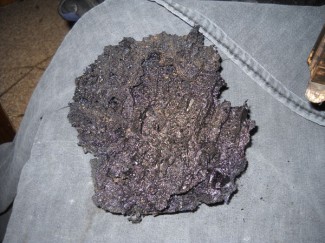When you have a wood-burning fireplace, creosote is a fact of life. A residue which forms naturally during the wood burning process, creosote sticks to the walls of your chimney and builds up deposits over weeks and months of using your fireplace. If you do not have your annual chimney sweeping from a company like Ashbusters that employs Chimney Safety Institute of America (CSIA)-certified chimney sweeps, your chimney could have large amounts of creosote inside, just waiting to start a dangerous chimney fire. We would like to tell you what exactly creosote is, its dangers, and how you can prevent large creosote deposits building up on your chimney’s walls.
What is creosote and how does it form?
As the CSIA states, dirty chimneys cause chimney fires, and creosote deposits are the most hazardous of all the dirt in your chimney, as this residue is highly combustible. How exactly does creosote form? When wood burns, by-products of combustion, like smoke, gases, vapors, tar fog, unburned wood particles, hydrocarbon, and other minerals, are produced, and your chimney works to expel these. As these by-products exit through your cooler, upper chimney walls, condensation occurs, and the resulting residue from this entire process is creosote, which sticks to the inner walls of your chimney.
Why is creosote so dangerous?
Black or brown in color, creosote can have different appearances: flaky and cracked, sticky and gummy, or shiny and hardened. No matter what it looks like, all creosote can appear in all three different forms in your chimney, and all forms are highly combustible. If creosote builds up large enough in your chimney, it is an extremely dangerous fire hazard because if your internal flue reaches a high enough temperature, you will have a chimney fire waiting to happen. Removing creosote deposits is one of the main reasons the CSIA, the National Fire Safety Association, and other chimney safety organizations recommend you have your chimney swept annually. A professional chimney sweeping from Ashbusters will rid your chimney from all of the creosote deposits sticking to your chimney walls. Our CSIA-certified sweeps are experienced in creosote removal and guarantee a clean chimney after the job is done.
How can I discourage creosote from forming large deposits?
While creosote happens naturally and there is really nothing you can do to prevent it from forming, certain conditions do encourage creosote building up, and you can do things to slow down this development. One of the factors that accelerate creosote deposits is restricted air supply. Closing the glass fireplace doors, failing to open the damper wide enough, and the lack of enough time to move the hot smoke out of the chimney quickly enough all restrict your chimney’s air supply and actually speed up the building up of creosote on your chimney walls. To prevent this, open your fireplace doors once in a while, and make sure your damper is always extended as open as possible while you are burning a fire. These two steps will help to slow down creosote build-up. Another factor that encourages creosote deposits is burning unseasoned wood. Your fireplace takes up so much energy burning off water trapped in the cells of the unseasoned wood logs that the resulting smoke is cooler, and cooler smoke temperatures create the perfect environment in your chimney for creosote build-up. You can easily remedy this by only burning seasoned firewood.
Have more questions about creosote and its dangers? Contact Ashbusters to talk to our staff about anything else you want to know about this highly combustible compound.

